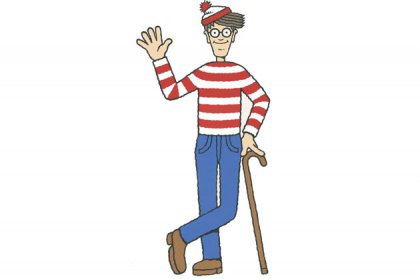How Does Our Brain Find Waldo?

Many studies have researched how certain ads and commercials affect our attention and our memory. Do you remember some of those iconic commercials like the Wendy’s “Where’s the Beef?”, or Tony the Tiger convincing us that those Frosted Flakes are truly “grrrrrrreat!”? Those are the ads I am talking about.
A study carried out in the United States in 2009 looked into the impact of commercials and ads like these on our memory and on the process of clearly remembering the brand of the ad. There have also been a series of neurological studies that have begun to shed light on how we visually process the information we receive from websites and the role that marketing plays in the online world.
A clear example to better understand all of this is the classic book and game, “Where’s Waldo?”.
Where’s Waldo?
Where’s Waldo? is a well-known book series that offers the reader a game and an exercise in visual attention. Created by Martin Handford, this game and exercise of our visual attention has been represented in the form of two dozen books, video games, an animated series, and even in a movie.
Waldo (called Wally in the U.K.) is a boy with glasses, a cap, and a red and white striped sweater, who hides in crowds full of distractions, which make him very difficult to find.
Setting aside the superficial details, let’s think: How much time does it take us to find a specific item in a setting that is visually busy or full? How do our eyes seek out Waldo in an image that is dense, full of little details and false visual clues?
These were the questions that researchers Robert Desimone, director of the McGovern Institute for Brain Research at MIT, and Don Berkey, professor of Neuroscience at MIT, decided to tackle. Specifically, they wanted to explore two different schools of thought:
Do we move our eyes across a page as if we were a scanner, meticulously examining it centimeter by centimeter?
Or, on the other hand, do we scan the image of the page itself as a unit, looking for clues in the general pattern and bigger picture of where Waldo could be?

The answer seems to be both at once. The reason is that we have two different systems that are active, both of which we have developed over time. We have to focus our attention on the task in question, but we also have to analyze the environment so we do not overlook anything that might need our attention at any moment.
The way in which the brain does this is fascinating. It does it through the creation of a set of neurons, which are all propelling themselves in a synchronized pattern. It seems that this synchronization is the representation of the concentration of our attention.
Looking for Waldo in the Crowd
Let’s go back to Waldo. Neurons tend to have specialized functions. We have neurons that are best at choosing colors, others for identifying shapes, and others for discerning and identifying patterns.
In the case of finding Waldo, before we begin scanning the page, we engage the neurons that are most adept at recognizing the distinct image of Waldo. For example, because Waldo has red on his clothes, we call upon the red neurons. This way, we create an image of Waldo in our “mind’s eye;” we have our “neuron detective” ready to intercept Waldo.
Foveal Attention and Peripheral Attention
How do we actually find Waldo? This is when the two mental mechanisms work in unison.
To better understand how it works, we are going to explain the difference between foveal attention and peripheral attention:
Foveal attention is when the brain focuses our eyes specifically with the part that allows us to pick up small details. When we read, for example, we use this foveal focus to recognize and interpret the shapes of the letters. Scanning only captures our foveal attention. This represents the “spotlight” function.
However, the brain has to tell the eyes how they should keep on moving. This is based in peripheral attention. This is what we see out of the “corner of our eye.”
Peripheral attention allows our eyes to scan a much wider area. Its objective is to determine if there are elements in our field of vision that deserve the foveal attention. Peripheral vision is especially refined to pick up vague movements and visual signals. This has a significant impact on the effectiveness of marketing.
So, let’s say that our neural team has already identified the objective pattern we are looking for, and this image has implanted itself in our prefrontal cortex.
When looking for Waldo through our peripheral vision, we begin to scan the whole image to find possible coincidences. To help separate the more promising parts of the image from the details that are simply background noise, an area of the pre-frontal cortex organizes our neurons to synchronize and capture important details.
This process serves to also distinguish characteristic sounds in the middle of a lot of noise. For example, try to pay attention to a musician playing on the other side of a crowded plaza.
This is how our foveal attention centers on those parts of the image that are most probably going to be Waldo. That is when a more detailed scan comes into play in order to determine if it truly is the real Waldo.
So what are the practical implications of all this? This same basic process is what happens when we visit a website. When online marketers and web designers are trying to”capture” our attention, our memory, and our interest, they might use the lessons from the Waldo study. Next time you visit a website, see if you notice how your eye and brain absorbs the information!
Many studies have researched how certain ads and commercials affect our attention and our memory. Do you remember some of those iconic commercials like the Wendy’s “Where’s the Beef?”, or Tony the Tiger convincing us that those Frosted Flakes are truly “grrrrrrreat!”? Those are the ads I am talking about.
A study carried out in the United States in 2009 looked into the impact of commercials and ads like these on our memory and on the process of clearly remembering the brand of the ad. There have also been a series of neurological studies that have begun to shed light on how we visually process the information we receive from websites and the role that marketing plays in the online world.
A clear example to better understand all of this is the classic book and game, “Where’s Waldo?”.
Where’s Waldo?
Where’s Waldo? is a well-known book series that offers the reader a game and an exercise in visual attention. Created by Martin Handford, this game and exercise of our visual attention has been represented in the form of two dozen books, video games, an animated series, and even in a movie.
Waldo (called Wally in the U.K.) is a boy with glasses, a cap, and a red and white striped sweater, who hides in crowds full of distractions, which make him very difficult to find.
Setting aside the superficial details, let’s think: How much time does it take us to find a specific item in a setting that is visually busy or full? How do our eyes seek out Waldo in an image that is dense, full of little details and false visual clues?
These were the questions that researchers Robert Desimone, director of the McGovern Institute for Brain Research at MIT, and Don Berkey, professor of Neuroscience at MIT, decided to tackle. Specifically, they wanted to explore two different schools of thought:
Do we move our eyes across a page as if we were a scanner, meticulously examining it centimeter by centimeter?
Or, on the other hand, do we scan the image of the page itself as a unit, looking for clues in the general pattern and bigger picture of where Waldo could be?

The answer seems to be both at once. The reason is that we have two different systems that are active, both of which we have developed over time. We have to focus our attention on the task in question, but we also have to analyze the environment so we do not overlook anything that might need our attention at any moment.
The way in which the brain does this is fascinating. It does it through the creation of a set of neurons, which are all propelling themselves in a synchronized pattern. It seems that this synchronization is the representation of the concentration of our attention.
Looking for Waldo in the Crowd
Let’s go back to Waldo. Neurons tend to have specialized functions. We have neurons that are best at choosing colors, others for identifying shapes, and others for discerning and identifying patterns.
In the case of finding Waldo, before we begin scanning the page, we engage the neurons that are most adept at recognizing the distinct image of Waldo. For example, because Waldo has red on his clothes, we call upon the red neurons. This way, we create an image of Waldo in our “mind’s eye;” we have our “neuron detective” ready to intercept Waldo.
Foveal Attention and Peripheral Attention
How do we actually find Waldo? This is when the two mental mechanisms work in unison.
To better understand how it works, we are going to explain the difference between foveal attention and peripheral attention:
Foveal attention is when the brain focuses our eyes specifically with the part that allows us to pick up small details. When we read, for example, we use this foveal focus to recognize and interpret the shapes of the letters. Scanning only captures our foveal attention. This represents the “spotlight” function.
However, the brain has to tell the eyes how they should keep on moving. This is based in peripheral attention. This is what we see out of the “corner of our eye.”
Peripheral attention allows our eyes to scan a much wider area. Its objective is to determine if there are elements in our field of vision that deserve the foveal attention. Peripheral vision is especially refined to pick up vague movements and visual signals. This has a significant impact on the effectiveness of marketing.
So, let’s say that our neural team has already identified the objective pattern we are looking for, and this image has implanted itself in our prefrontal cortex.
When looking for Waldo through our peripheral vision, we begin to scan the whole image to find possible coincidences. To help separate the more promising parts of the image from the details that are simply background noise, an area of the pre-frontal cortex organizes our neurons to synchronize and capture important details.
This process serves to also distinguish characteristic sounds in the middle of a lot of noise. For example, try to pay attention to a musician playing on the other side of a crowded plaza.
This is how our foveal attention centers on those parts of the image that are most probably going to be Waldo. That is when a more detailed scan comes into play in order to determine if it truly is the real Waldo.
So what are the practical implications of all this? This same basic process is what happens when we visit a website. When online marketers and web designers are trying to”capture” our attention, our memory, and our interest, they might use the lessons from the Waldo study. Next time you visit a website, see if you notice how your eye and brain absorbs the information!
This text is provided for informational purposes only and does not replace consultation with a professional. If in doubt, consult your specialist.







